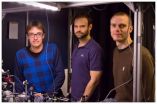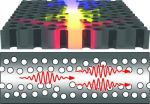(Press-News.org) Researchers the world round are working to develop optical chips, where light can be controlled with nanostructures. These could be used for future circuits based on light (photons) instead of electron - that is photonics instead of electronics. But it has proved to be impossible to achieve perfect photonic nanostructures: they are inevitably a little bit imperfect. Now researchers at the Niels Bohr Institute in collaboration with DTU have discovered that imperfect nanostructures can offer entirely new functionalities. They have shown that imperfect optical chips can be used to produce 'nanolasers', which is an ultimately compact and energy-efficient light source. The results are published in the scientific journal Nature Nanotechnology.
The researchers are working with extremely small photonic crystal membranes - the width of the membrane is 25 micrometer (1 micrometer is one thousandth of a millimeter), and the thickness is 340 nanometers (1 nanometer is one thousandth of a micrometer). The crystals are made of the semiconducting material gallium arsenide (GaAs). A pattern of holes are etched into the material at a regular distance of 380 nanometers. The holes have the function of acting as built-in mirrors that reflect the light and can thus be used to control the spread of the light in the optical chip. The researchers have therefore tried to achieve as perfect a regular structure of holes as possible to control the light in certain optical circuit.
Unavoidable disorder exploited
But in practice it is impossible to avoid small irregularities during the manufacture of the optical chips and this can be a big problem, as it can result in the loss of light and therefore reduced functionality. Researchers at the Niels Bohr Institute have now turned the problem of imperfections into an advantage.
"It turns out that the imperfect optical chips are extremely well suited for capturing light. When the light is sent into the imperfect chip, it will hit the many small irregular holes, which reflect the light in random directions. Due to the frequent reflections, the light is spontaneously captured in the nanostructure and cannot escape. This allows the light to be amplified, resulting in surprisingly good conditions for creating highly efficient and compact lasers," explains Peter Lodahl, professor and head of the Quantum Photonic research group at the Niels Bohr Institute at the University of Copenhagen.
Experiment with built-in light
The researchers in Quantum Photonics at the Niels Bohr Institute, led by Professor Peter Lodahl and Associate Professor Søren Stobbe, designed the photonic crystal and carried out the experimental studies in the research group's laboratories.
The light source is integrated into the photonic crystal itself and is comprised of a layer of artificial atoms that emit light (the basic component of light is photons). The photons are sent through the crystal, which is clear as glass and has a pattern of tiny holes. When a photon hits a hole it is reflected and channeled into the so-called waveguide, which is a 'photon track' that can be used to guide the photons through the photonic crystal. However, due to the imperfect holes the light will be thrown back and forth in the waveguide of the photonic crystal, intensifying it and turning it into laser light.
The result is laser light on a nanometer scale and the researchers see great potential in this.
The dream of a quantum Internet
"The fact that we can control the light and produce laser light on a nanometer scale can be used to create circuits based on photons instead of electrons, thus paving the way for optical quantum communication technology in the future. With built-in laser sources, we will be able to integrate optical components and it allows for the building of complex functionalities. Our ultimate dream is to build a 'quantum internet', where the informations is coded in individual photons," explain Peter Lodahl and Søren Stobbe, who are excited about the results, which show that the unavoidable disorder in optical chip is not a limitation and can even be exploited under the right conditions.
INFORMATION:
For further information contact:
Peter Lodahl, Professor, Quantum Photonics, Niels Bohr Institute, University of Copenhagen,
+45 2056-5303, lodahl@nbi.ku.dk - http://www.quantum-photonics.dk
Søren Stobbe, Associate Professor, Quantum Photonics, Niels Bohr Institute, University of Copenhagen, +45 3532-5216, stobbe@nbi.ku.dk - http://www.quantum-photonics.dk
Unavoidable disorder used to build nanolaser
2014-03-23
ELSE PRESS RELEASES FROM THIS DATE:
Could diamonds be a computer's best friend?
2014-03-23
COLUMBUS, Ohio—For the first time, physicists have demonstrated that information can flow through a diamond wire.
In the experiment, electrons did not flow through diamond as they do in traditional electronics; rather, they stayed in place and passed along a magnetic effect called "spin" to each other down the wire—like a row of sports spectators doing "the wave."
Spin could one day be used to transmit data in computer circuits—and this new experiment, done at The Ohio State University, revealed that diamond transmits spin better than most metals in which researchers ...
Leukaemia caused by chromosome catastrophe
2014-03-23
Researchers have found that people born with a rare abnormality of their chromosomes have a 2,700-fold increased risk of a rare childhood leukaemia. In this abnormality, two specific chromosomes are fused together but become prone to catastrophic shattering.
Acute lymphoblastic leukaemia, or ALL, is the most common childhood cancer. Scientists previously found that a small subset of ALL patients have repeated sections of chromosome 21 in the genomes of their leukaemia cells. This form of ALL – iAMP21 ALL – requires more intensive treatment than many other types of ALL. ...
Drugs fail to reawaken dormant HIV infection
2014-03-23
Scientists at Johns Hopkins report that compounds they hoped would "wake up" dormant reservoirs of HIV inside immune system T cells — a strategy designed to reverse latency and make the cells vulnerable to destruction — have failed to do so in laboratory tests of such white blood cells taken directly from patients infected with HIV.
"Despite our high hopes, none of the compounds we tested in HIV-infected cells taken directly from patients activated the latent virus," says Robert F. Siliciano, M.D., Ph.D., a professor of medicine at the Johns Hopkins University School ...
MIT engineers design 'living materials'
2014-03-23
CAMBRIDGE, MA -- Inspired by natural materials such as bone — a matrix of minerals and other substances, including living cells — MIT engineers have coaxed bacterial cells to produce biofilms that can incorporate nonliving materials, such as gold nanoparticles and quantum dots.
These "living materials" combine the advantages of live cells, which respond to their environment, produce complex biological molecules, and span multiple length scales, with the benefits of nonliving materials, which add functions such as conducting electricity or emitting light.
The new materials ...
Off-rift volcanoes explained
2014-03-23
Potsdam: Rift valleys are large depressions formed by tectonic stretching forces. Volcanoes often occur in rift valleys, within the rift itself or on the rift flanks as e.g. in East Africa. The magma responsible for this volcanism is formed in the upper mantle and ponds at the boundary between crust and mantle. For many years, the question of why volcanoes develop outside the rift zone in an apparently unexpected location offset by tens of kilometers from the source of molten magma directly beneath the rift has remained unanswered. A team of scientists from the GFZ German ...
Southeast England most at risk of rising deaths due to climate change
2014-03-23
Warmer summers brought on by climate change will cause more deaths in London and southeast England than the rest of the country, scientists predict.
Researchers at Imperial College London looked at temperature records and mortality figures for 2001 to 2010 to find out which districts in England and Wales experience the biggest effects from warm temperatures.
In the most vulnerable districts, in London and the southeast, the odds of dying from cardiovascular or respiratory causes increased by over 10 per cent for every 1C rise in temperature. Districts in the far north ...
TGen-led study discovers genetic cause of rare type of ovarian cancer
2014-03-23
PHOENIX, Ariz. — March 23, 2014 — The cause of a rare type of ovarian cancer that most often strikes girls and young women has been uncovered by an international research team led by the Translational Genomics Research Institute (TGen), according to a study published online today by the renowned scientific journal, Nature Genetics.
By applying its groundbreaking work in genomics, TGen led a study that included Mayo Clinic, Johns Hopkins University, St. Joseph's Hospital and Medical Center; Evergreen Hematology and Oncology, Children's Hospital of Alabama, the Autonomous ...
Shifting evolution into reverse promises cheaper, greener way to make new drugs
2014-03-23
This alternative approach to creating artificial organic molecules, called bioretrosynthesis, was first proposed four years ago by Brian Bachmann, associate professor of chemistry at Vanderbilt University. Now Bachmann and a team of collaborators report that they have succeeded in using the method to produce the HIV drug didanosine.
The proof of concept experiment is described in a paper published online March 23 by the journal Nature Chemical Biology.
"These days synthetic chemists can make almost any molecule imaginable in an academic laboratory setting," said Bachmann. ...
HPV eradicated by AHCC supplement, preclinical study suggests
2014-03-23
(March 23, 2014, Beaverton, OR) Treating cervical cancer cells with AHCC led to the eradication of HPV, human papillomavirus, as well as a decrease in the rate of tumor growth in-vitro and in-vivo, in research presented at the Society of Gynecological Oncology 45th Annual Meeting on Women's Cancer in Tampa, Florida. The study was led by Dr. Judith A. Smith, Pharm.D., at the University of Texas Health Science Center (UTHealth) Medical School at Houston.
In the study cervical cancer cells were treated with AHCC and incubated for 72 hours with sampling every 24 hours. The ...
Marblehead Resident Sean Whalen Named chairman of JDRF's Boston Walk to Cure Diabetes
2014-03-23
JDRF is the leading global organization funding type 1 diabetes (T1D) research. Their annual Boston walk, planned for Saturday, September 27 is expected to raise more than $1.3M for T1D research.
Whalen became involved with JDRF three years ago after his then three-year-old son, Jesse, was diagnosed with type 1 diabetes. Seeing the daily challenges Jesse faces, Whalen formed the "Jesse James Gang" team to participate in the JDRF Walk to Cure Diabetes. Over the past three years, the Jesse James Gang has raised more than $20,000.
"The JDRF Boston Walk ...

